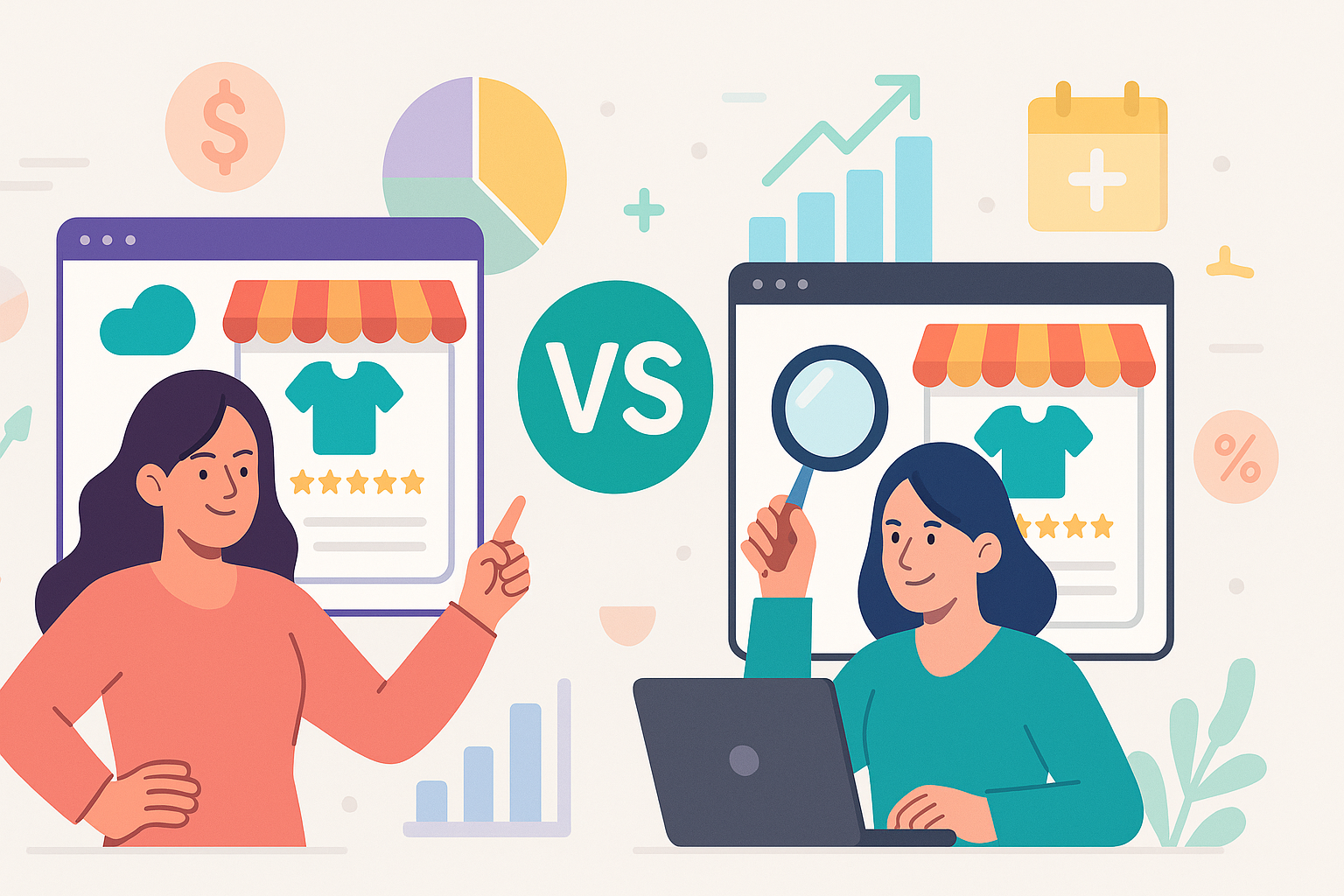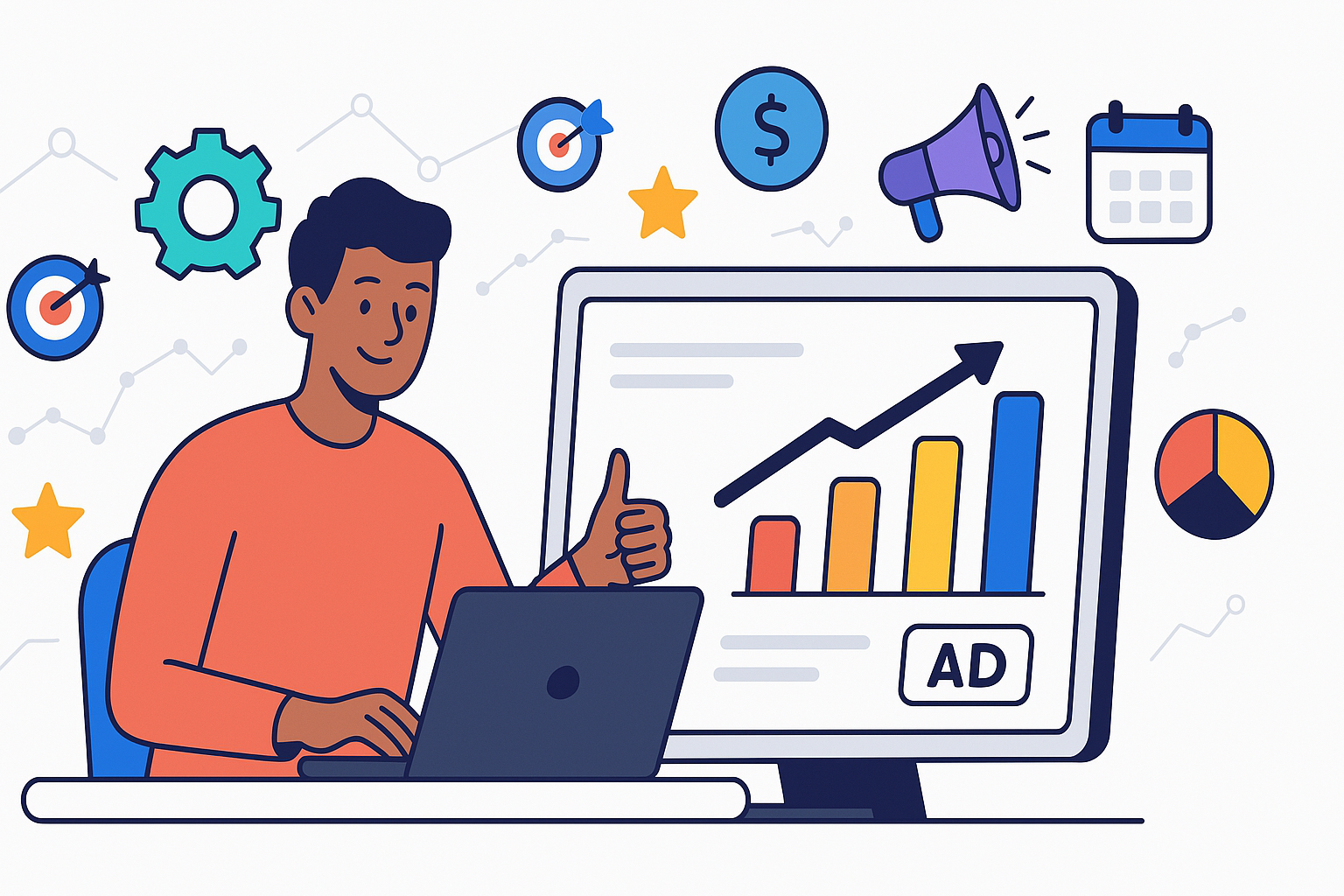Choosing the Right Google Ads Campaign Types for Maximum ROI
by Francisco Kraefft on 26 Dec, 2024
Google Ads offers a powerful, multifaceted platform to connect with potential customers across the digital landscape. However, navigating its diverse array of campaign types can feel overwhelming. Choosing the right campaign isn't just about preference; it's a critical strategic decision that directly impacts your budget allocation, targeting capabilities, ad formats, and ultimately, your return on investment (ROI). Understanding the specific purpose, strengths, and optimal use cases for each Google Ads campaign type is fundamental to crafting effective, data-driven advertising strategies. Whether your goal is driving immediate sales, building brand awareness, generating leads, or promoting app installs, there's a specialized campaign designed to help you achieve it. Let's explore these options to ensure you're leveraging the full potential of Google Ads for your business growth.
Master Google Search Campaigns: Reach Customers Actively Seeking Your Solutions
Search campaigns are often the cornerstone of a robust Google Ads strategy, and for good reason. These campaigns place your text ads directly on Google Search results pages (and sometimes on Google search partners' sites) precisely when users are actively looking for keywords related to your products or services. This is intent-driven marketing at its finest.
Why Use Search Campaigns?
- High Intent: You connect with users who have already expressed interest by typing specific search queries.
- Direct Response: Ideal for driving actions like website visits, lead form submissions, phone calls, and online sales.
- Control: Offers granular control over keywords, bids, ad copy, and targeting.
Key Components:
- Keywords: The foundation of Search campaigns. You bid on keywords relevant to what you offer. Rigorous keyword research (identifying relevant terms, search volume, competition, and intent) is crucial. Don't forget negative keywords – terms you don't want your ads to show for, which prevents wasted spend and improves relevance.
- Ad Copy: Compelling text ads are essential. They should include relevant keywords, a clear value proposition, and a strong call-to-action (CTA). Utilize Responsive Search Ads (RSAs), which allow you to provide multiple headlines and descriptions, letting Google's machine learning test combinations to find the best performers.
- Ad Extensions: These enhance your ads with additional information like site links, callouts, structured snippets, location details, phone numbers, and more. Extensions increase ad visibility (taking up more space on the results page) and provide users with more reasons to click, often improving click-through rates (CTR).
- Bidding Strategies: Google offers various bidding strategies. You can manually set bids (Manual CPC) or leverage automated bidding based on your goals:
- Maximize Clicks: Aims to get the most clicks within your budget.
- Maximize Conversions: Focuses on driving the most conversions.
- Target CPA (Cost Per Acquisition): Sets bids to help get as many conversions as possible at or below your target cost. Learn how to calculate CPA.
- Target ROAS (Return On Ad Spend): Sets bids to maximize conversion value based on your target return. Learn how to calculate ROAS.
- Enhanced CPC (eCPC): Adjusts manual bids up or down based on the likelihood of a click leading to a conversion.
- Quality Score: This metric estimates the quality of your ads, keywords, and landing pages. Higher Quality Scores can lead to lower ad costs and better ad positions. It's influenced by expected CTR, ad relevance, and landing page experience.
Best Use Cases:
- Lead generation for service-based businesses.
- Driving sales for e-commerce stores (often used alongside Shopping campaigns).
- Promoting specific offers or events.
- Capturing bottom-of-the-funnel traffic ready to convert.
Optimizing Search campaigns involves continuous monitoring of performance data, refining keyword lists, A/B testing ad copy, adjusting bids, and improving landing page relevance. When executed correctly, Search campaigns deliver highly qualified traffic and tangible results.
Expand Your Reach: Leveraging Google Display Campaigns for Brand Awareness
While Search campaigns capture existing demand, Google Display campaigns excel at generating demand and building brand awareness across a vast network. The Google Display Network (GDN) comprises millions of websites, news pages, blogs, and Google sites like Gmail and YouTube, potentially reaching over 90% of internet users worldwide.
Why Use Display Campaigns?
- Massive Reach: Connect with potential customers early in the buying cycle across a huge inventory of sites and apps.
- Visual Appeal: Utilize engaging image, responsive, and rich media ad formats.
- Targeting Options: Offers diverse targeting methods beyond keywords to reach specific audiences.
- Cost-Effective Awareness: Often provides lower cost-per-click (CPC) or cost-per-mille (CPM) compared to Search, making it suitable for branding goals.
Key Components:
- Targeting Methods: This is where Display shines. You can target based on:
- Audiences: Reach users based on their interests, habits, and intent (Affinity, In-Market, Custom Audiences, Life Events, Remarketing).
- Demographics: Target based on age, gender, parental status, and household income.
- Content: Show ads on specific website topics, placements (specific websites or apps), or alongside specific keywords (contextual targeting).
- Ad Formats:
- Responsive Display Ads (RDAs): The default and most flexible format. You upload assets (images, headlines, logos, videos, descriptions), and Google automatically creates ad combinations that fit various placements. This maximizes reach and performance.
- Uploaded Image Ads: Standard banner ads in various sizes (e.g., 300x250, 728x90, 160x600). Gives more creative control but requires creating multiple sizes.
- Bidding Strategies: Common goals for Display include awareness, consideration, and conversions. Bidding strategies reflect this:
- Viewable CPM (vCPM): Pay per 1,000 viewable impressions. Learn more about CPM.
- Maximize Clicks: Drive traffic to your website.
- Target CPA/Maximize Conversions: Optimize for actions if conversion tracking is set up (often used for remarketing).
- Remarketing (Retargeting): A powerful use case for Display. Show ads to users who have previously visited your website or interacted with your brand, reminding them of your offerings and encouraging them to return.
Best Use Cases:
- Building brand awareness and visibility.
- Reaching new audiences at the top of the marketing funnel.
- Remarketing to past website visitors or customers.
- Promoting visual products or services.
- Supporting Search campaigns by building brand recognition.
Display campaigns require careful audience selection and compelling creative assets. While not always driving immediate conversions like Search, their strength lies in broadening your reach, nurturing potential customers, and keeping your brand top-of-mind. Monitor placements and audience performance closely to refine targeting and optimize budget allocation.
Drive Engagement with Google Video Campaigns: Formats and Strategies
Video consumption is booming, and Google Video campaigns allow you to tap into this trend by placing ads on YouTube and across the Google Display Network's video partners. Video ads offer a dynamic and engaging way to tell your brand story, demonstrate products, and connect with audiences on a deeper level.
Why Use Video Campaigns?
- High Engagement: Capture attention with sight, sound, and motion.
- Storytelling Power: Communicate complex messages or brand narratives effectively.
- Targeted Reach: Leverage Google's powerful audience targeting capabilities on YouTube, the world's second-largest search engine.
- Measurable Impact: Track views, view-through rates (VTR), clicks, conversions, and brand lift metrics.
Key Ad Formats:
- Skippable In-Stream Ads: Play before, during, or after other YouTube videos. Users can skip after 5 seconds. You typically pay when a user watches 30 seconds (or the full video if shorter) or interacts with the ad (Cost-Per-View, CPV).
- Non-Skippable In-Stream Ads: Up to 15-20 seconds long (depending on region), cannot be skipped. Sold on a Target CPM (Cost Per Mille) basis, ideal for maximizing message exposure.
- In-Feed Video Ads (formerly Video Discovery Ads): Appear alongside organic YouTube search results, on the YouTube homepage, and in the 'Watch Next' feed. Consist of a thumbnail image and text. You pay when a user clicks the thumbnail to watch the ad (CPV).
- Bumper Ads: Short, non-skippable 6-second ads sold on a Target CPM basis. Excellent for delivering quick, memorable messages and increasing reach/frequency.
- Outstream Ads: Mobile-only ads appearing on partner websites and apps outside of YouTube. Designed to expand reach beyond YouTube, often starting muted with users tapping to unmute. Billed on vCPM.
- Masthead Ads: Premium placement available via reservation directly with Google sales. Appear at the top of the YouTube homepage for massive reach over a short period.
Targeting & Bidding:
- Targeting: Similar robust options as Display campaigns (Demographics, Audiences: Affinity, In-Market, Custom, Life Events, Remarketing, Topics, Placements, Keywords). You can specifically target YouTube channels or videos.
- Bidding: Common strategies include:
- CPV (Cost Per View): Pay for views or interactions.
- Target CPM: Pay per thousand impressions.
- Target CPA / Maximize Conversions: Optimize for actions, requires conversion tracking.
- Maximize Lift: Drive positive perception and consideration for your brand (requires Brand Lift measurement).
Best Use Cases:
- Building brand awareness and consideration.
- Product demonstrations or tutorials.
- Driving website traffic or leads (using CTAs and extensions).
- Announcing new products or promotions.
- Reaching specific interest-based audiences.
Success with Video campaigns hinges on creating compelling video content tailored to the chosen format and audience. A/B test different creatives, CTAs, and targeting options. Analyze performance metrics like VTR, completion rate, and conversions to understand what resonates best and optimize your campaigns accordingly.
Maximize E-commerce Sales: Understanding Shopping and Performance Max Campaigns
For e-commerce businesses, driving product sales is paramount. Google offers specialized campaign types designed specifically for this: traditional Shopping campaigns and the newer, all-encompassing Performance Max.
Standard Shopping Campaigns:
These campaigns display your products directly in Google Search results (as Product Listing Ads - PLAs), the Shopping tab, Google Images, and on search partner websites. They show users a photo of your item, its title, price, store name, and more, making them highly effective for attracting ready-to-buy shoppers.
- Key Requirements: A Google Merchant Center account with an up-to-date product feed is essential. This feed contains all the necessary product attributes (ID, title, description, price, image link, availability, etc.) that Google uses to create your ads.
- Structure: Instead of keywords, you organize and bid on product groups within your campaign, often based on categories, brands, or individual item IDs.
- Bidding: Typically focuses on maximizing conversions or achieving a Target ROAS. Smart Bidding strategies are highly recommended.
- Advantages: High visibility for products, strong purchase intent, granular control over product groups and bids (compared to PMax).
- Best Use Cases: E-commerce businesses wanting direct control over which products are advertised and how much is spent on specific product categories. Often relevant for platforms like Shopify.
Performance Max (PMax) Campaigns:
Performance Max represents a significant shift towards automation and goal-based campaigning. It's designed to find more converting customers across all of Google's channels – Search, Display, YouTube, Discover, Gmail, and Maps – from a single campaign.
- How it Works: You provide Google with your conversion goals, budget, and creative assets (text, images, videos, logos). You also provide audience signals (like customer lists, custom segments, interests) to help steer the automation. Google's machine learning then automatically determines the optimal inventory, bidding, and ad combinations to maximize performance against your goals.
- Asset Groups: Instead of ad groups and keywords, you organize your assets (images, text, videos, feeds) into Asset Groups, often themed around specific products or services.
- Product Feed Integration: Crucially for e-commerce, PMax integrates directly with your Google Merchant Center feed, allowing it to serve dynamic Shopping ads alongside other formats across all channels.
- Advantages: Maximum reach across all Google properties, simplified campaign management, leverages powerful machine learning for optimization, potential to uncover new conversion opportunities.
- Challenges: Less granular control and reporting compared to standard campaign types (often referred to as a 'black box'), requires high-quality creative assets and clear conversion goals for the algorithm to work effectively.
- Best Use Cases: Advertisers focused on specific conversion goals (online sales, lead generation), seeking the widest possible reach, comfortable with automation, have strong conversion tracking in place, and can provide diverse creative assets.
Shopping vs. PMax:
Many e-commerce advertisers now run PMax alongside or instead of Standard Shopping. PMax often takes priority over Standard Shopping for the same products. The choice depends on your goals and comfort level with automation. Standard Shopping offers more control, while PMax offers broader reach and potentially higher volume, leveraging automation across all channels.
Both campaign types are powerful tools for e-commerce. Success requires a well-structured, optimized product feed, clear conversion goals, and continuous monitoring of performance data (perhaps using tools like Looker Studio or Google Analytics) to inform strategy and budget adjustments.
Niche Targeting: Leveraging App, Local, and Discovery Campaigns
Beyond the core campaign types, Google Ads offers specialized options tailored to specific business objectives like promoting mobile apps, driving foot traffic to physical locations, or reaching audiences in discovery-focused feeds.
1. App Campaigns:
If your primary goal is to increase installs for your mobile app or drive specific in-app actions (like registrations, purchases, or reaching a certain level in a game), App campaigns are the way to go. These campaigns are highly automated, designed to simplify the process of promoting your app across Google's largest properties.
- Reach: App ads run across Google Search, Google Play, YouTube, Google Display Network, and Discover.
- Automation: You provide text ideas, starting bids, budget, languages, locations, and optionally, images, videos, and HTML5 assets. Google's AI then tests different combinations and placements to find users most likely to install or perform your desired in-app action.
- Bidding: Focuses on goals like Target Cost Per Install (tCPI) or Target Cost Per Action (tCPA) for in-app events. Understanding your CPA is crucial.
- Key Requirement: Requires linking your Google Play Developer account or providing the App Store ID, and setting up conversion tracking for installs and in-app actions (often via Firebase or third-party measurement partners).
- Best Use Cases: Businesses focused on mobile app growth (installs, engagement, in-app purchases).
2. Local Campaigns:
Designed specifically for businesses with physical locations (stores, restaurants, dealerships), Local campaigns aim to drive offline outcomes: store visits, calls to the business, and clicks on driving directions. These are key for strategies on how to promote business locally.
- Reach: Ads appear across Google Search, Google Maps, YouTube, and the Google Display Network, targeting users near your business locations.
- Optimization: Campaigns are optimized automatically to maximize store visits (using anonymized, aggregated data) and other local actions.
- Setup: Requires linking your Google Business Profile (formerly Google My Business) account. You provide budget, ad copy, images, and videos.
- Measurement: Focuses on tracking store visits (estimated based on location data), clicks for calls, and clicks for directions.
- Best Use Cases: Retailers, restaurants, service providers, and any business aiming to increase foot traffic and local customer interactions.
3. Discovery Campaigns:
Discovery campaigns help you reach up to 3 billion people across Google's most popular feeds: the Google Discover feed (on the Google app homepage), YouTube Home and Watch Next feeds, and Gmail's Promotions and Social tabs. These campaigns use visually rich, native ad formats designed to capture attention as users browse content they enjoy.
- Focus: Reaching users based on their interests and behavior across Google's platforms, rather than active search intent.
- Ad Formats: Utilize single-image or multi-image carousel ads, leveraging compelling visuals and headlines.
- Targeting: Primarily relies on Google's powerful audience targeting options (Affinity, In-Market, Custom Audiences, Remarketing, Demographics).
- Bidding: Automated bidding strategies like Maximize Conversions or Target CPA are used to drive actions like website visits or conversions.
- Best Use Cases: Reaching new customers based on interests, driving mid-funnel consideration, visually showcasing products or services, remarketing with engaging visuals.
These specialized campaigns allow you to align your advertising efforts more closely with specific, niche business goals. Understanding when and how to deploy App, Local, or Discovery campaigns can unlock significant value by connecting with the right audiences in the right context, whether it's on their mobile device, near your physical store, or while they're exploring new content online.
Conclusion
Selecting the appropriate Google Ads campaign type is not a trivial choice; it's a strategic imperative. Each campaign – Search, Display, Video, Shopping, Performance Max, App, Local, and Discovery – serves distinct purposes and caters to different stages of the customer journey. By aligning your campaign selection with your specific marketing objectives, target audience behaviors, and available creative assets, you lay the foundation for efficient budget allocation and impactful results. Remember, the digital landscape is dynamic. Continuous monitoring, data analysis, and optimization are key to refining your approach and maximizing your return on investment (ROI) across all your Google Ads initiatives.
Ready to optimize your Google Ads strategy and drive measurable growth? Let our data-driven experts craft the perfect campaign mix for your business. Contact us today for a personalized consultation!


